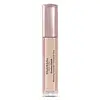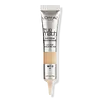What's inside
What's inside
 Key Ingredients
Key Ingredients

 Benefits
Benefits

 Concerns
Concerns

 Ingredients Side-by-side
Ingredients Side-by-side

Water
Skin ConditioningDimethicone
EmollientTrimethylsiloxysilicate
EmollientGlycerin
HumectantPhenyl Trimethicone
Skin ConditioningZinc Oxide
Cosmetic ColorantPEG/PPG-18/18 Dimethicone
EmulsifyingBoron Nitride
AbsorbentBis-PEG/PPG-14/14 Dimethicone
EmollientSodium Chloride
MaskingTribehenin
EmollientButylene Glycol
Humectant1,2-Hexanediol
Skin ConditioningAlumina
AbrasiveCaprylyl Glycol
EmollientDimethiconol
EmollientHydrogen Dimethicone
Methicone
EmollientMethyl Methacrylate Crosspolymer
Mica
Cosmetic ColorantSilica
AbrasiveSodium Hyaluronate
HumectantSorbitan Sesquioleate
EmulsifyingTetrahexyldecyl Ascorbate
AntioxidantTetrasodium EDTA
Tocopheryl Acetate
AntioxidantTriethoxycaprylylsilane
Trisiloxane
Skin ConditioningPhenoxyethanol
PreservativeCI 77163
Cosmetic ColorantCI 77491
Cosmetic ColorantCI 77492
Cosmetic ColorantCI 77499
Cosmetic ColorantCI 77891
Cosmetic ColorantWater, Dimethicone, Trimethylsiloxysilicate, Glycerin, Phenyl Trimethicone, Zinc Oxide, PEG/PPG-18/18 Dimethicone, Boron Nitride, Bis-PEG/PPG-14/14 Dimethicone, Sodium Chloride, Tribehenin, Butylene Glycol, 1,2-Hexanediol, Alumina, Caprylyl Glycol, Dimethiconol, Hydrogen Dimethicone, Methicone, Methyl Methacrylate Crosspolymer, Mica, Silica, Sodium Hyaluronate, Sorbitan Sesquioleate, Tetrahexyldecyl Ascorbate, Tetrasodium EDTA, Tocopheryl Acetate, Triethoxycaprylylsilane, Trisiloxane, Phenoxyethanol, CI 77163, CI 77491, CI 77492, CI 77499, CI 77891
Water
Skin ConditioningGlycerin
HumectantCaprylyl Methicone
Skin ConditioningPropanediol
SolventDimethicone
EmollientPentylene Glycol
Skin ConditioningDimethicone/PEG-10/15 Crosspolymer
Alcohol Denat.
AntimicrobialSodium Hyaluronate
HumectantSodium Chloride
MaskingTriethoxysilylethyl Polydimethylsiloxyethyl Dimethicone
Skin ConditioningIsopropyl Titanium Triisostearate
EmollientPhenoxyethanol
PreservativeAscorbyl Glucoside
AntioxidantCaprylyl Glycol
EmollientTrisodium Ethylenediamine Disuccinate
Alumina
AbrasiveDipropylene Glycol
HumectantSodium Citrate
BufferingTocopherol
AntioxidantCI 77891
Cosmetic ColorantCI 77491
Cosmetic ColorantCI 77492
Cosmetic ColorantCI 77499
Cosmetic ColorantCI 77163
Cosmetic ColorantMica
Cosmetic ColorantWater, Glycerin, Caprylyl Methicone, Propanediol, Dimethicone, Pentylene Glycol, Dimethicone/PEG-10/15 Crosspolymer, Alcohol Denat., Sodium Hyaluronate, Sodium Chloride, Triethoxysilylethyl Polydimethylsiloxyethyl Dimethicone, Isopropyl Titanium Triisostearate, Phenoxyethanol, Ascorbyl Glucoside, Caprylyl Glycol, Trisodium Ethylenediamine Disuccinate, Alumina, Dipropylene Glycol, Sodium Citrate, Tocopherol, CI 77891, CI 77491, CI 77492, CI 77499, CI 77163, Mica
Ingredients Explained
These ingredients are found in both products.
Ingredients higher up in an ingredient list are typically present in a larger amount.
Alumina is another name for the compound aluminum oxide. It is used as a thickener, absorbent, and abrasive.
As an absorbent, alumina can give a mattifying effect. It is used in mineral sunscreens to help coat nano-sized filters, such as titanium dioxide. By increasing the size of the UV filters, these ingredients stay on the skin for a longer time. By coating small sized ingredients, alumina helps thicken a product.
Alumina may be used as an abrasive, or exfoliant.
Alumina is naturally occurring in the mineral corundum. Certain varieties of corundum create rubies and sapphires. Corundum is also the crystalline form of alumina.
Learn more about AluminaCaprylyl Glycol is a humectant and emollient, meaning it attracts and preserves moisture.
It is a common ingredient in many products, especially those designed to hydrate skin. The primary benefits are retaining moisture, skin softening, and promoting a healthy skin barrier.
Though Caprylyl Glycol is an alcohol derived from fatty acids, it is not the kind that can dry out skin.
This ingredient is also used as a preservative to extend the life of products. It has slight antimicrobial properties.
Learn more about Caprylyl GlycolThis synthetic powder is used to add a pearly/white color in cosmetics.
Ci 77491 is also hydrated iron III oxide. It's sole purpose is to give a red/pink hue to products.
Iron III oxides are classified as inorganic chemicals for coloring.
Synthetically created Ci 77491 is considered safer than those naturally found. This is because the synthetically created version may contain less impurities. Iron oxides are generally non-toxic and non-allergenic.
Learn more about CI 77491Ci 77492 is also hydrated iron III oxide. It's sole purpose is to give a yellow hue to products.
Iron III oxides are classified as inorganic chemicals for coloring.
Synthetically created Ci 77492 is considered safer than those naturally found. This is because the synthetically created version may contain less impurities. Iron oxides are generally non-toxic and non-allergenic.
Learn more about CI 77492Ci 77499 is also hydrated iron III oxide. It is created from mixing red and black iron oxides. This helps give shades of darkness to a product.
Iron III oxides are classified as inorganic chemicals for coloring.
Ci 77891 is a white pigment from Titanium dioxide. It is naturally found in minerals such as rutile and ilmenite.
It's main function is to add a white color to cosmetics. It can also be mixed with other colors to create different shades.
Ci 77891 is commonly found in sunscreens due to its ability to block UV rays.
Learn more about CI 77891Dimethicone is a type of synthetic silicone created from natural materials such as quartz.
What it does:
Dimethicone comes in different viscosities:
Depending on the viscosity, dimethicone has different properties.
Ingredients lists don't always show which type is used, so we recommend reaching out to the brand if you have questions about the viscosity.
This ingredient is unlikely to cause irritation because it does not get absorbed into skin. However, people with silicone allergies should be careful about using this ingredient.
Note: Dimethicone may contribute to pilling. This is because it is not oil or water soluble, so pilling may occur when layered with products. When mixed with heavy oils in a formula, the outcome is also quite greasy.
Learn more about DimethiconeGlycerin is already naturally found in your skin. It helps moisturize and protect your skin.
A study from 2016 found glycerin to be more effective as a humectant than AHAs and hyaluronic acid.
As a humectant, it helps the skin stay hydrated by pulling moisture to your skin. The low molecular weight of glycerin allows it to pull moisture into the deeper layers of your skin.
Hydrated skin improves your skin barrier; Your skin barrier helps protect against irritants and bacteria.
Glycerin has also been found to have antimicrobial and antiviral properties. Due to these properties, glycerin is often used in wound and burn treatments.
In cosmetics, glycerin is usually derived from plants such as soybean or palm. However, it can also be sourced from animals, such as tallow or animal fat.
This ingredient is organic, colorless, odorless, and non-toxic.
Glycerin is the name for this ingredient in American English. British English uses Glycerol/Glycerine.
Learn more about GlycerinMica is a naturally occurring mineral used to add shimmer and color in cosmetics. It can also help improve the texture of a product or give it an opaque, white/silver color.
Serecite is the name for very fine but ragged grains of mica.
This ingredient is often coated with metal oxides like titanium dioxide. Trace amounts of heavy metals may be found in mica, but these metals are not harmful in our personal products.
Mica has been used since prehistoric times throughout the world. Ancient Egyptian, Indian, Greek, Roman, Aztec, and Chinese civilizations have used mica.
Learn more about MicaPhenoxyethanol is a preservative that has germicide, antimicrobial, and aromatic properties. Studies show that phenoxyethanol can prevent microbial growth. By itself, it has a scent that is similar to that of a rose.
It's often used in formulations along with Caprylyl Glycol to preserve the shelf life of products.
Chances are, you eat sodium chloride every day. Sodium Chloride is also known as table salt.
This ingredient has many purposes in skincare: thickener, emulsifier, and exfoliator.
You'll most likely find this ingredient in cleansers where it is used to create a gel-like texture. As an emulsifier, it also prevents ingredients from separating.
There is much debate on whether this ingredient is comedogenic. The short answer - comedogenic ratings don't tell the whole story. Learn more about comegodenic ratings here.
The concensus about this ingredient causing acne seems to be divided. Research is needed to understand if this ingredient does cause acne.
Scrubs may use salt as the primary exfoliating ingredient.
Learn more about Sodium ChlorideSodium Hyaluronate is hyaluronic acid's salt form. It is commonly derived from the sodium salt of hyaluronic acid.
Like hyaluronic acid, it is great at holding water and acts as a humectant. This makes it a great skin hydrating ingredient.
Sodium Hyaluronate is naturally occurring in our bodies and is mostly found in eye fluid and joints.
These are some other common types of Hyaluronic Acid:
Learn more about Sodium HyaluronateWater. It's the most common cosmetic ingredient of all. You'll usually see it at the top of ingredient lists, meaning that it makes up the largest part of the product.
So why is it so popular? Water most often acts as a solvent - this means that it helps dissolve other ingredients into the formulation.
You'll also recognize water as that liquid we all need to stay alive. If you see this, drink a glass of water. Stay hydrated!
Learn more about Water